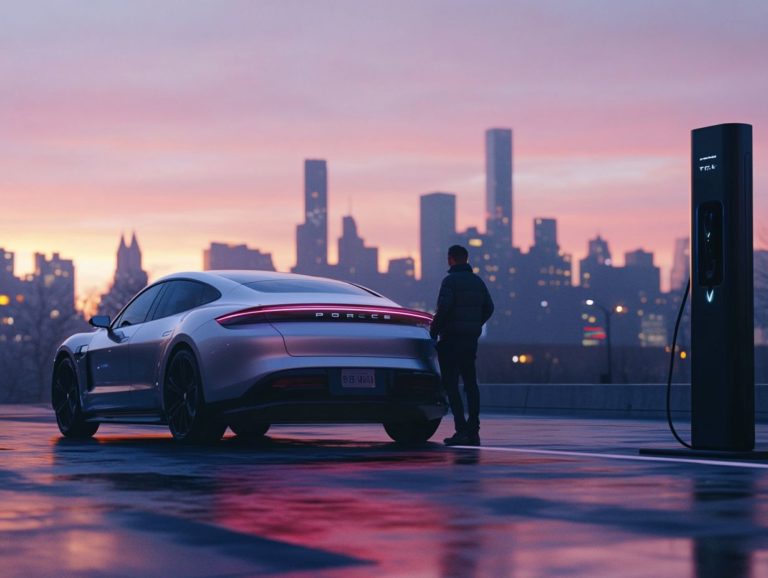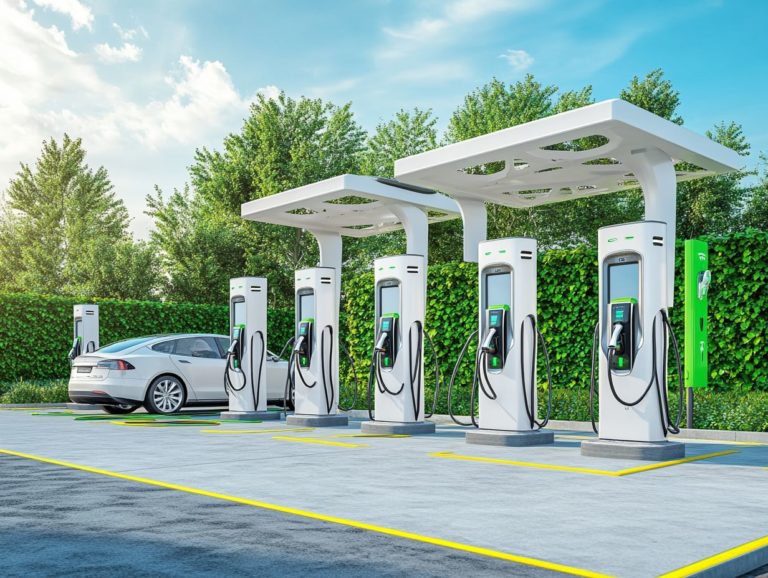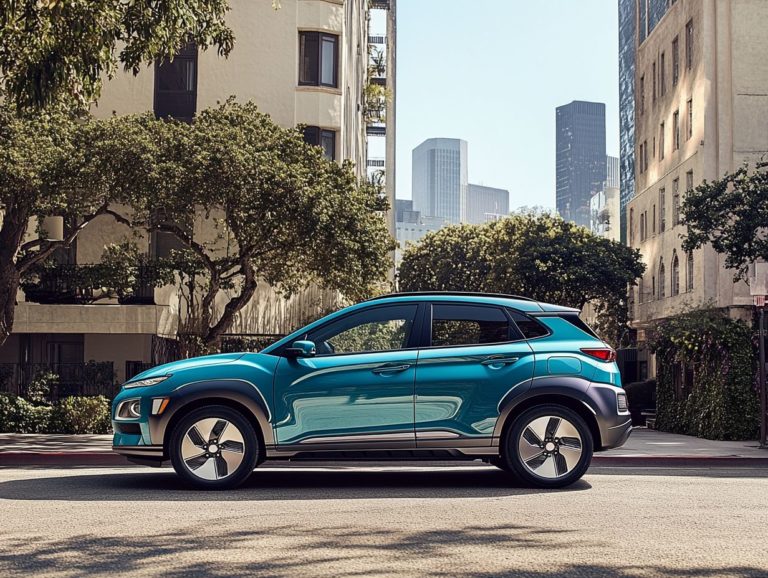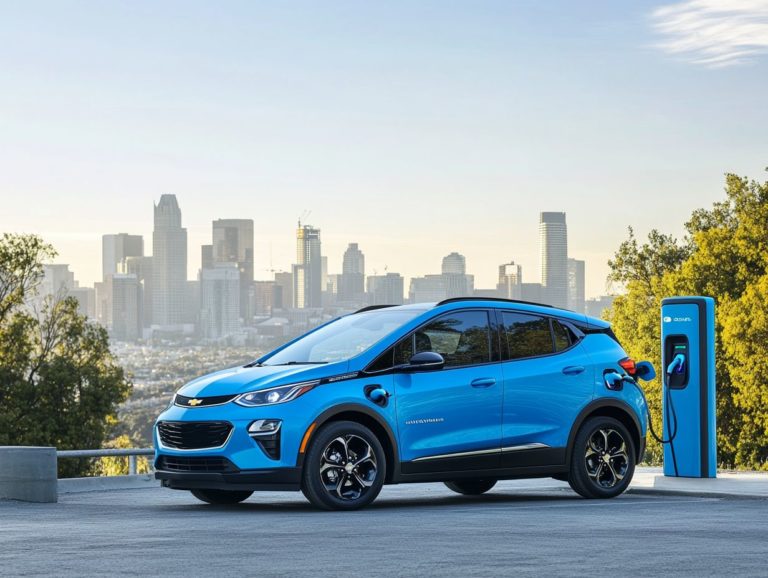The Role of Electric Vehicles in Urban Planning
As cities worldwide contend with pollution, traffic congestion, and the pressing challenges of climate change, electric vehicles (EVs) are emerging as essential players in urban planning.
Not only do EVs serve as eco-friendly alternatives to traditional cars, but they also significantly enhance air quality, reduce noise pollution, and lessen reliance on fossil fuels.
This article delves into the myriad benefits of integrating electric vehicles into urban settings, the challenges that accompany this transition, and the inspiring examples of cities that are leading the way.
Explore how EVs have the potential to transform urban landscapes into cleaner, quieter, and more sustainable environments for all.
Contents
- Key Takeaways:
- The Benefits of Electric Vehicles in Urban Planning
- Challenges and Considerations for Implementing Electric Vehicles in Urban Planning
- Successful Examples of Electric Vehicle Integration in Urban Planning
- Frequently Asked Questions
- What is the role of electric vehicles in urban planning?
- How do electric vehicles contribute to sustainable urban development?
- What challenges do urban planners face when incorporating electric vehicles into city plans?
- What are the benefits of electric vehicles for urban residents?
- How can urban planners encourage adoption of electric vehicles?
- Are there any potential drawbacks to electric vehicles in urban planning?
Key Takeaways:
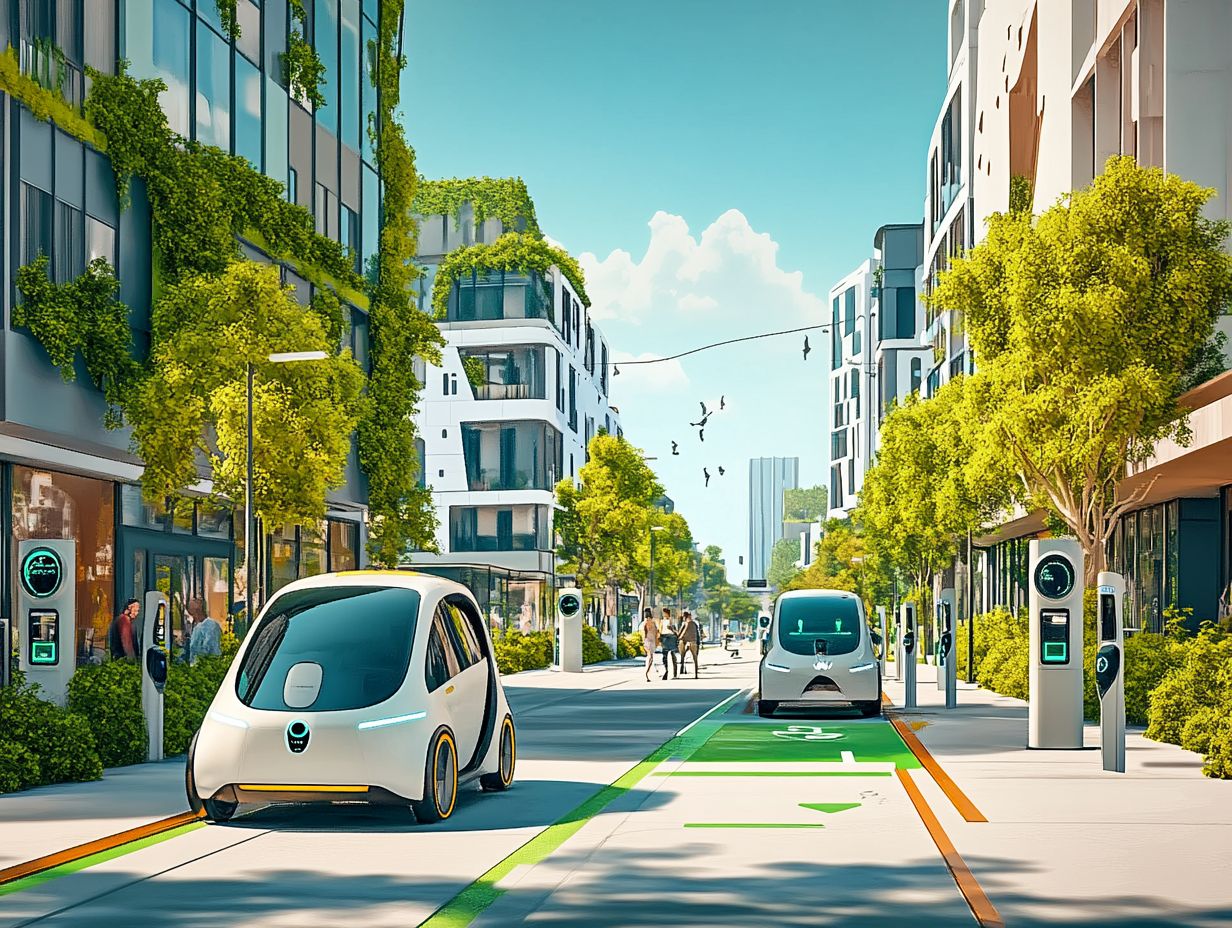
- Electric vehicles are game-changers for urban planning!
- Challenges in implementing electric vehicles include infrastructure and charging stations, costs, and impact on public transportation.
- Successful examples of electric vehicle integration in urban planning can provide valuable lessons and best practices for other cities to follow.
What are Electric Vehicles?
Electric Vehicles (EVs) are transforming transportation. They offer a compelling alternative to gasoline-powered vehicles.
This shift promotes clean mobility and supports using electric vehicles.
With ongoing technological advances, EVs are becoming easier to access. Urban planning now focuses on building charging stations and different types of transportation.
The electric vehicle market is diverse, featuring battery electric vehicles (BEVs), plug-in hybrid electric vehicles (PHEVs), and fuel cell electric vehicles (FCEVs), each offering distinct advantages tailored to your urban commuting needs.
Essential components, such as high-capacity batteries, efficient electric drivetrains, and regenerative braking systems, enhance both performance and energy efficiency.
Urban areas stand to gain immensely from adopting EVs. They significantly reduce air pollution and noise, creating healthier living spaces for everyone.
By integrating robust charging networks, cities are setting the stage for widespread EV adoption, ultimately leading to a more resilient and eco-friendly urban infrastructure.
The Benefits of Electric Vehicles in Urban Planning
Integrating electric vehicles into urban planning presents a wealth of benefits that significantly enhance urban development, delivering cleaner air, reduced emissions, and improved public transit options.
As cities transition into smart urban environments, the demand for sustainable transportation solutions becomes paramount.
By thoughtfully incorporating charging infrastructure and urban charging hubs into their planning initiatives, city planners can not only facilitate EV adoption but also elevate urban livability.
This approach also encourages community engagement around clean transportation, creating a more vibrant and sustainable urban landscape for all.
Reducing Emissions and Improving Air Quality
Electric vehicles are essential to reducing emissions and improving air quality. These are key objectives in today s urban planning initiatives. By swapping out traditional fossil fuel vehicles for EVs, you can significantly cut greenhouse gas emissions. This ultimately fosters healthier urban environments and enhances public health.
Embracing clean mobility, or transport options that do not pollute the air, combats climate change and enriches urban livability. This creates enjoyable communities for residents.
Recent studies reveal that widely embracing electric vehicles could slash carbon emissions from urban transport by as much as 70% within the next decade. This transition diminishes harmful pollutants that contribute to respiratory issues and positively impacts overall public health by reducing cases of asthma and heart diseases linked to poor air quality.
Cities that prioritize improved air quality through strategic urban planning and invest in charging infrastructure reap economic benefits. Healthier populations typically exhibit higher productivity levels and lower healthcare costs, paving the way for more sustainable and resilient urban frameworks.
Reducing Noise Pollution
One often-overlooked benefit of electric vehicles is their remarkable ability to reduce noise pollution in urban environments. This enhances overall livability. Unlike traditional gasoline-powered vehicles, EVs operate with a whisper, cultivating a more serene atmosphere in densely populated areas.
This transition brings greater comfort for residents and positively influences mental well-being by easing stress typically associated with city life. Picture quieter streets that boost your focus and creativity, allowing you to engage more meaningfully with your surroundings.
Effective urban planning can encourage the growth of electric vehicles by incorporating dedicated charging stations and prioritizing eco-friendly infrastructure. By considering the holistic impact of noise reduction, urban planners can create inclusive spaces that promote tranquility and make cities more inviting for everyone.
Reducing Dependence on Fossil Fuels
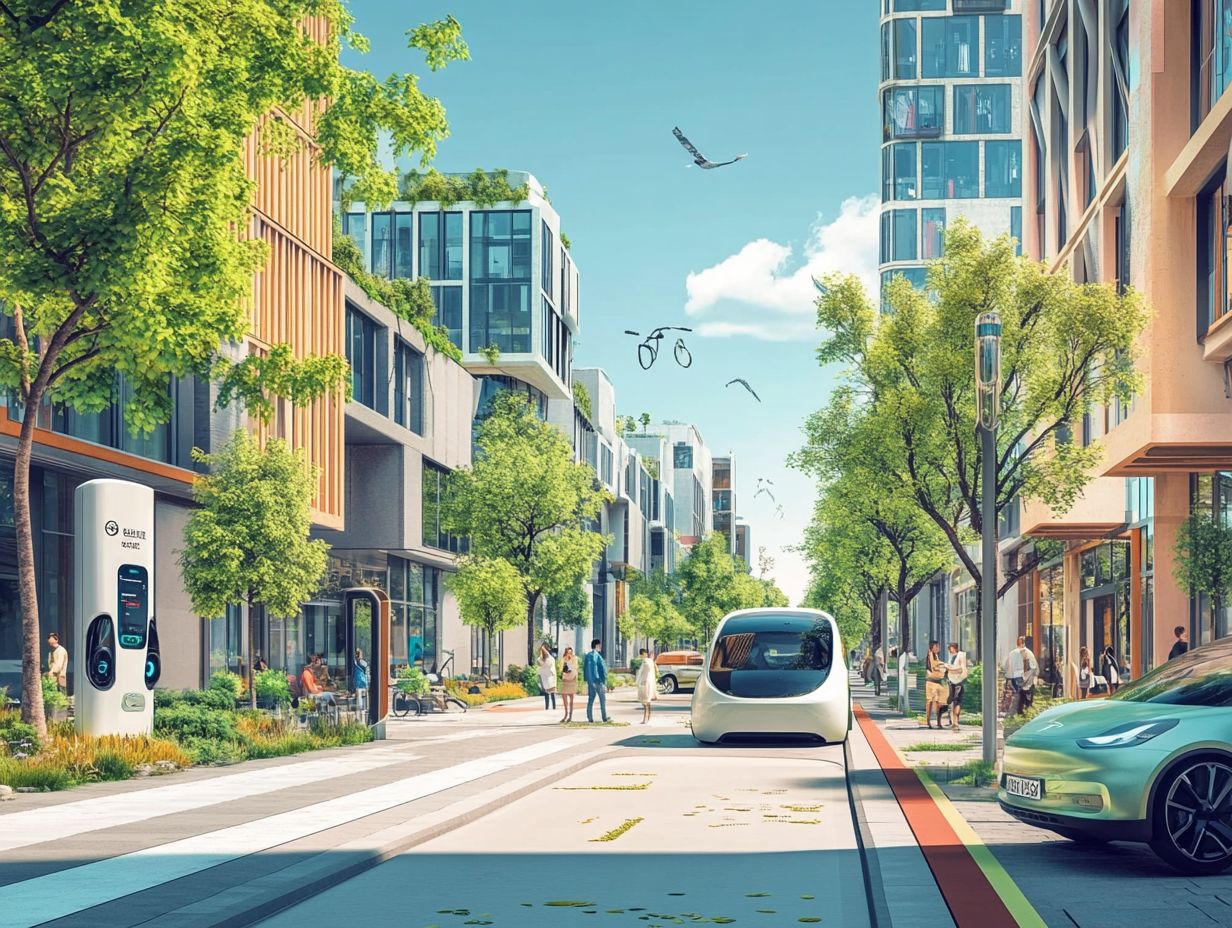
Reducing your dependence on fossil fuels is crucial in the transition to electric vehicles. This paves the way for energy independence and the utilization of renewable energy. As cities embrace EVs in their urban planning, they promote greater sustainability and resilience within their power grids.
This transformation contributes to the fight against climate change and encourages the development of local renewable energy sources. It fosters a sustainable transportation ecosystem while lowering energy costs and creating new job opportunities in the renewable energy sector.
Investing in infrastructure that supports electric vehicle charging and alternative energy sources attracts businesses and drives technological innovations. This comprehensive approach enhances public health by reducing air pollution and builds a community enabled by energy independence, leading to a more stable and self-reliant economy. As cities integrate these initiatives, you prepare for a greener, more efficient future.
Challenges and Considerations for Implementing Electric Vehicles in Urban Planning
The advantages of incorporating electric vehicles into urban planning are abundant, but you must address several challenges for successful implementation. One primary concern is the necessity for substantial infrastructure upgrades, including a comprehensive network of charging stations and urban charging hubs to facilitate EV adoption.
Fostering collaboration among stakeholders is crucial to addressing obstacles related to costs, enhancing public awareness, and ensuring that urban development strategies align seamlessly with clean mobility goals.
Infrastructure and Charging Stations
The establishment of a strong charging network is essential for the widespread adoption of electric vehicles in urban areas. This requires strategic planning and collaboration among city planners. Urban charging hubs and conveniently located stations are crucial elements that enable seamless EV usage for both residents and commuters.
By prioritizing these infrastructure upgrades, cities can create an environment that supports sustainable transportation while enhancing the overall user experience.
Integrating charging solutions into urban development plans benefits individual commuters and fosters community-wide advantages, such as reduced emissions and improved air quality. City planners must pinpoint the best spots for charging stations to make them accessible and convenient, ensuring they are near public transport hubs and align with the growing needs of electric mobility.
Fostering partnerships with private companies and organizations can boost funding and innovation, leading to a wider range of charging options. Incorporating smart technology into charging stations can enhance energy efficiency and enable real-time availability tracking, further encouraging the transition to electric vehicles.
Costs and Affordability
Costs and affordability play a crucial role in incorporating electric vehicles into urban planning, impacting both city budgets and consumer adoption rates. The initial investment for electric vehicle infrastructure charging stations, maintenance, and other related components can be quite hefty.
However, don’t underestimate the power of public-private partnerships; they can significantly alleviate these financial burdens and enhance accessibility for communities. By fostering collaboration among stakeholders, cities can devise cost-effective strategies that promote EV adoption and ensure urban development remains sustainable.
Cities must act quickly to explore diverse funding opportunities, such as grants and tax incentives, to relieve financial pressures on both urban planners and consumers. Integrating electric vehicles into existing transportation systems aligns beautifully with modern environmental goals and can yield long-term economic benefits.
By prioritizing affordability in their planning, municipalities can elevate public transit systems and encourage a shift from traditional vehicles to electric alternatives. This strategic approach can set the stage for vibrant, eco-friendly urban environments that effectively meet the evolving needs of their residents.
Impact on Public Transportation
The integration of electric vehicles, especially electric buses, significantly transforms public transportation systems in urban areas. By embracing electric public transit options, cities can enhance mobility solutions and reduce emissions, leading to marked improvements in air quality and urban livability.
It’s crucial for urban planning efforts to account for electric vehicles in shaping future public transit strategies, ensuring alignment with sustainability goals.
These electric buses not only minimize noise pollution but also present substantial economic benefits, boasting lower operational and maintenance costs compared to traditional diesel models. As municipalities invest in the necessary infrastructure for charging stations, they create opportunities for innovative partnerships and community engagement, fostering greater acceptance of green technologies among residents.
The shift towards electrification in buses mirrors broader trends in urban mobility that prioritize efficiency and sustainability, allowing cities to adapt to evolving environmental standards and public expectations. Ultimately, electric buses are essential in reimagining urban transit, transforming cities into cleaner and more efficient environments for both residents and visitors.
By prioritizing electric buses, cities can lead the charge towards a cleaner future let s embrace this change together!
Successful Examples of Electric Vehicle Integration in Urban Planning
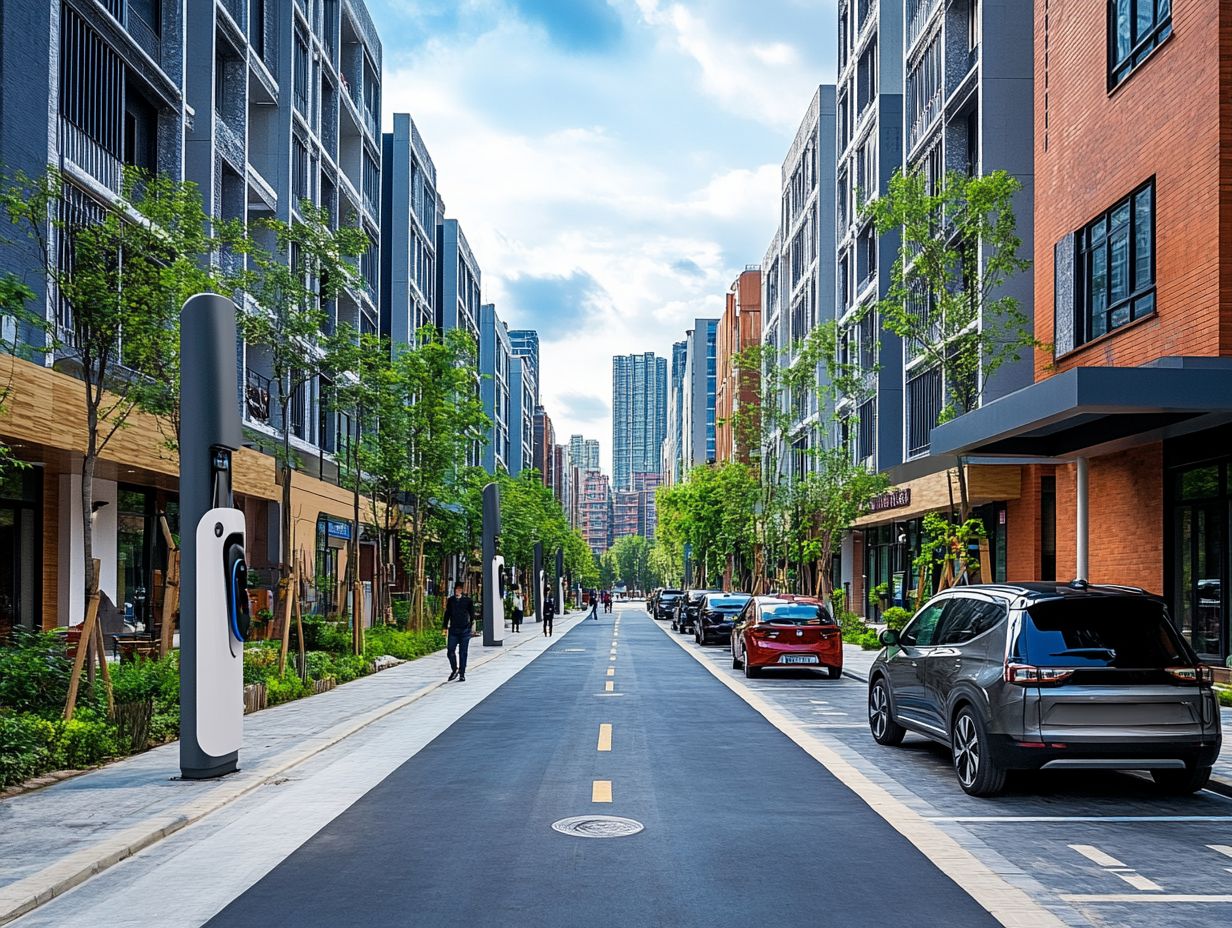
Numerous cities across the globe have adeptly woven electric vehicles into their urban planning strategies. These examples show the importance of collaboration, innovative infrastructure, and community involvement in promoting EV adoption.
By examining these case studies, you can uncover effective methods to seamlessly integrate electric vehicles into your urban development initiatives.
Cities with Successful Electric Vehicle Programs
Cities like Amsterdam, Shenzhen, and San Francisco are shining examples of successful electric vehicle programs. They illustrate how urban planning can effectively blend sustainable transportation solutions.
Through targeted policies and innovative partnerships, these cities have navigated various challenges, including initial resistance and the substantial investments needed for infrastructure.
Take Amsterdam, for instance; its robust government incentives and engagement programs have inspired both businesses and residents to switch to electric vehicles.
Meanwhile, Shenzhen has made headlines by deploying an impressive fleet of electric buses, showing the vital role public transport plays in emission reduction.
San Francisco, with its tech-savvy reputation, has introduced smart charging stations and collaborated with local businesses to amplify the message of electric mobility. These initiatives highlight the essential role of collaboration and showcase the significant impact that strategic urban planning can have in fostering a more sustainable urban environment.
Lessons Learned and Best Practices
The lessons from successful electric vehicle programs in various cities provide valuable insights for your urban planning efforts. By emphasizing community engagement and effective collaboration, you can significantly improve the chances of implementing successful EV strategies.
These best practices align with sustainable transportation goals and contribute to enhanced urban livability and environmental sustainability.
Consider strategies like:
- Host community workshops to gather local input,
- Prioritize investments in charging networks,
- Foster partnerships with businesses and non-profits to drive meaningful change.
Integrating EV infrastructure in your urban plans is essential for a sustainable future! It allows you to address current transportation needs while anticipating future demands. Don t overlook the potential of incentives for residents and businesses to encourage the transition to electric options.
By focusing on these actionable steps, you can create a more sustainable and interconnected environment that supports the growth of electric vehicles, ultimately benefiting the community.
Frequently Asked Questions
What is the role of electric vehicles in urban planning?
Electric vehicles can greatly improve urban planning by reducing emissions and enhancing air quality.
How do electric vehicles contribute to sustainable urban development?

Electric vehicles provide an eco-friendly transportation option, reducing reliance on fossil fuels and promoting sustainable city infrastructure.
What challenges do urban planners face when incorporating electric vehicles into city plans?
Challenges include the need for charging infrastructure, balancing transportation options for all residents, and addressing potential impacts on the electricity grid.
Join the movement towards sustainable urban living by integrating electric vehicle solutions today!
What are the benefits of electric vehicles for urban residents?
Electric vehicles offer lower operating costs. They also decrease noise pollution and improve air quality for residents. This makes urban living more sustainable and enjoyable.
How can urban planners encourage adoption of electric vehicles?
Urban planners can create incentives for electric vehicle ownership. These can include tax breaks, parking discounts, and investment in places where you can charge your electric vehicle.
Are there any potential drawbacks to electric vehicles in urban planning?
However, there are challenges to consider! One drawback is the initial cost of purchasing electric vehicles. Another is their limited driving range compared to traditional vehicles. Lastly, there is a need for continued investment in charging locations.

